A simulation study on energy use in residential buildings is currently underway in Greece with RINNO partners Hellenic Passive Building Institute (HPHI) and the Greek National Center for Research and Technological Development (CERTH). This project’s pilot site aims to create the most energy-efficient building in Greece by improving thermal comfort and energy consumption in an inhabited multi-family apartment residence. Read on for insights into how the Greek RINNO pilot site will bring deep renovation to building occupants via Passive House Standards, crowdfunding initiatives, and thermochromic windows.
What is the Greek RINNO pilot site?
The apartment building that functions as the Greek RINNO pilot site is located in the Moschatos-Tavros municipality in south Athens. The project, led by HPHI, aims to use the renovation learnings made as a feasibility study for renovating further apartment buildings and social housing complexes in the wider area. The project also aims to develop innovative financing strategies to attract investors and energy service companies in the region.
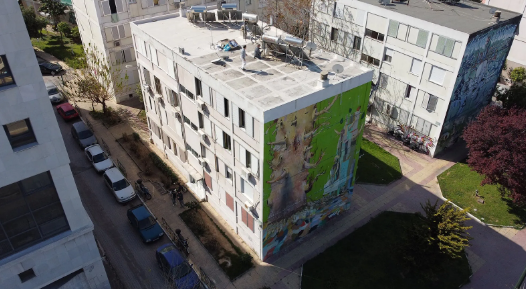
A bird’s eye view of the Greek pilot site
The site is a standard social 750 m2 multi-family house built in the 1970s to accommodate refugees. It currently houses eight families who regularly experience dire living conditions brought about by cold, wet winters and increasingly hot summers. High energy costs and wasteful cooling systems add financial strains, which the RINNO project also aims to address.
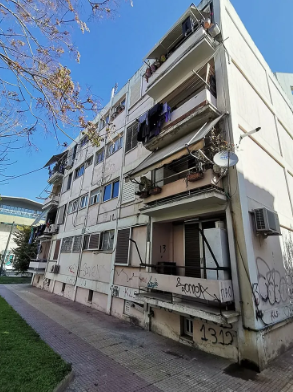
The current facade of the RINNO pilot site
What are Passive House Standards and how will they be implemented in Moschatos-Tavros?
Passive Buildings are designed to maintain a consistent indoor temperature throughout the year, with temperatures ranging between 20°C and 25°C and relative humidity levels between 35% and 55% regardless of outside temperatures. The CO2 concentration in Passive Buildings is generally kept below 1000 ppm.
The overall aim of implementing Passive House Standards in Moschatos-Tavros is to enable efficient energy regulation throughout and create one of the most energy-efficient buildings in Greece. In doing so, RINNO will further environmental, economic, and social stability both within the context of the building itself and, in a broader sense, in the surrounding area:
1. Environmental Impact
The pilot site’s specific environmental objectives include reducing the building’s cooling and heating requirements by 90% and heating the building only with electricity. This will be achieved by means of solar panels and is expected to exceed the total energy needed to operate the building, thus feeding the energy grid with more clean energy than it requires. The building will thus not only operate on clean energy, but also be a clean energy source for surrounding buildings. Through the use of renewable energy sources (RES), the building’s carbon emissions will also be reduced by 80%.
2. Social Impact
Ongoing renovation works and a reduction in the pilot site’s heating and cooling demand by 90% will equally reduce ensuing heating and cooling costs for occupants. In doing so, occupants will be less likely to experience energy poverty, which currently affects a large proportion of the Greek population. Since 2016, more than 58% of Greek households have experienced energy poverty, while 75% have reduced other essential expenses to accommodate energy costs. The pilot site renovations thus aim to drastically improve the quality of life.
The apartment building will also serve as a “living laboratory” for energy-efficient buildings. This will involve hosting demonstrations for stakeholders to disseminate learnings amongst 250 similar buildings housing more than 4,500 inhabitants in the area. Potentially replicating the deep renovation process created by RINNO works directly towards the project’s ultimate goal of creating a sustainable renovation framework across the full-life cycle of European residential buildings, and further supports positive social impact beyond the scope of the project’s four pilot sites.
3. Financial Impact
Access to capital is a significant barrier for deep renovation projects. As such, a crowdfunding campaign was launched in collaboration with Greenpeace and the Municipality of Moschatos-Tavros in late 2022 to support the implementation of the Greek RINNO pilot site and the families currently living in it. Crowdfunding in general is a means by which capital is collected from commercial and institutional actors who function as collective investors, thus giving private entrepreneurs more flexibility while competing with traditional financing channels.
All contributions to the RINNO crowdfunding campaign are welcome and can be made here (site in Greek). This innovative source of funding plays a key role in the implementation of the project and will be supported by gifts, advice on energy saving habits, and other benefits for all donors. Overall, the financial impact of the Greek pilot site is largely based on the renovation works made possible by this crowdfunding campaign and the massive energy savings for building occupants brought about by the use of renewable energy systems. This demonstrates a fullly sustainable investment strategy for construction industry stakeholders and energy providers
Which renovation measures are being implemented at RINNO’s Greek pilot site?
In combination with other renovation technologies like solar panels, virtual net metering and electric storage in energy communities, smart CO2, humidity, and temperature sensors, and sustainable Exterior Insulation and Finish Systems (EIFS), the Greek pilot site will make use of thermochromic windows to offer energy efficient housing for its residents.
Also known as smart windows, thermochromic windows are gaining popularity in building renovation projects as an innovative method for improving energy efficiency and reducing energy costs. Thermochromic windows can change their tint and transparency based on outside temperatures, which helps regulate temperatures inside the building and reduce the need for artificial heating, cooling, and lighting.
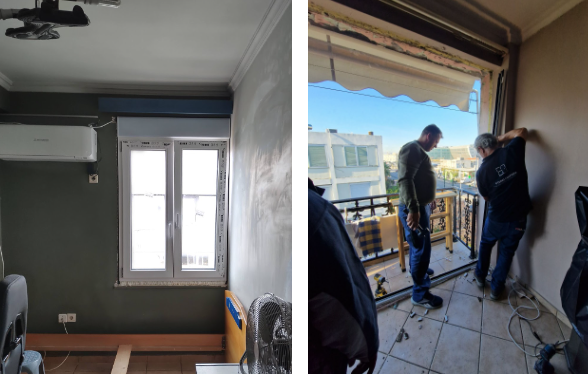
Installation of thermochromic windows at the RINNO Greek pilot site
In the summer, thermochromic windows can block the sun’s heat and reduce the need for air conditioning, or allow for more sunlight in the winter to reduce the need for heating. By regulating the temperature inside a building, thermochromic windows can reduce the energy consumption of lighting, heating, ventilation, and air conditioning (HVAC) systems and result in significant energy savings.
In addition to energy efficiency, thermochromic windows can also improve the comfort of building occupants. By blocking excess sunlight and heat in the summer, these windows create a more comfortable indoor environment. In the winter, they allow more natural light to enter.
In combination, these technologies will enable a reduction in heating energy requirements by 90% and reduce CO2 emissions by 80%. Estimated changes in heating requirements before and after the renovation works are shown per month below and indicate a yearly average sinking from 14.83 KWh/m2 to 0.75 KWh/m2:
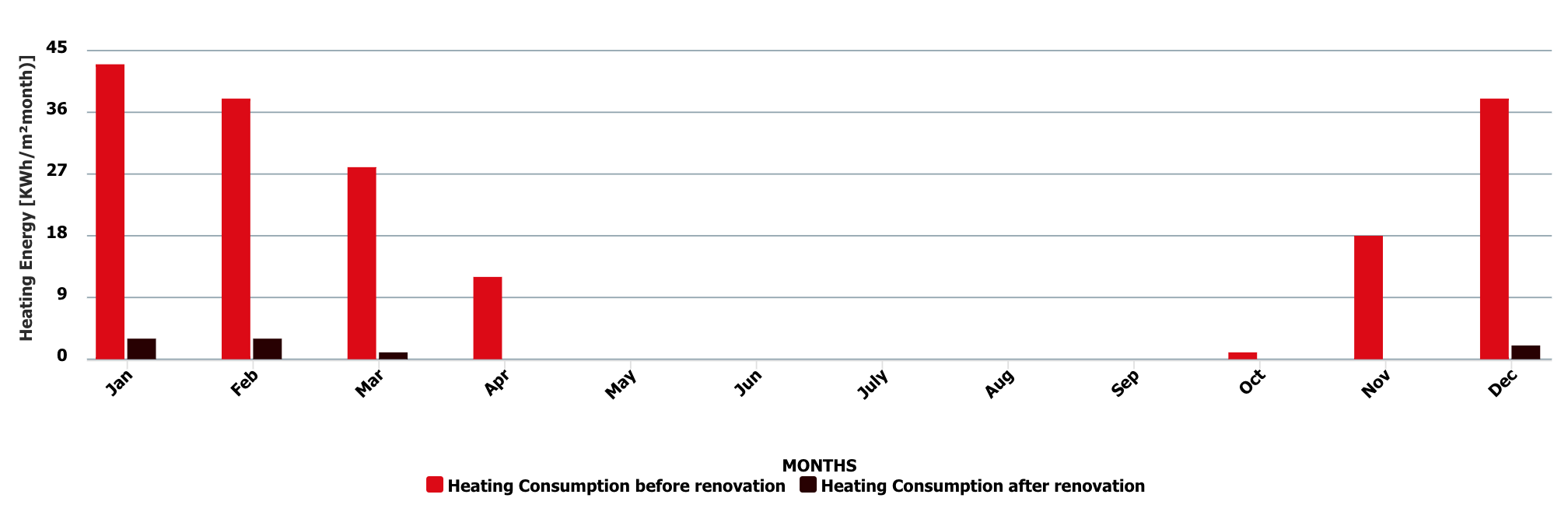 Estimated heating energy requirements before and after renovation, Credits: HPHI
Estimated heating energy requirements before and after renovation, Credits: HPHI
Similarly, CO2 levels will be reduced (Scenario 1 below) and even eliminated by the energy surplus generated by the employed solar panels (Scenario 2 below), sinking from 63,000 to 1,000 kg/a or 9,000 to -13,000 kg/a respectively:

Estimated CO2 emissions before and after renovation, Credits: HPHI
Lastly, energy costs will also be reduced following the completion of renovation works at Moschatos-Tavros. In the below, Scenarios 1 and 2 both describe a building in which the indoor temperature ranges from 20°C and 25°C, whereas the building in Scenario 2 has been renovated. Here, the energy cost for heating is reduced by 94.97% and the cooling energy cost by 71.75%.
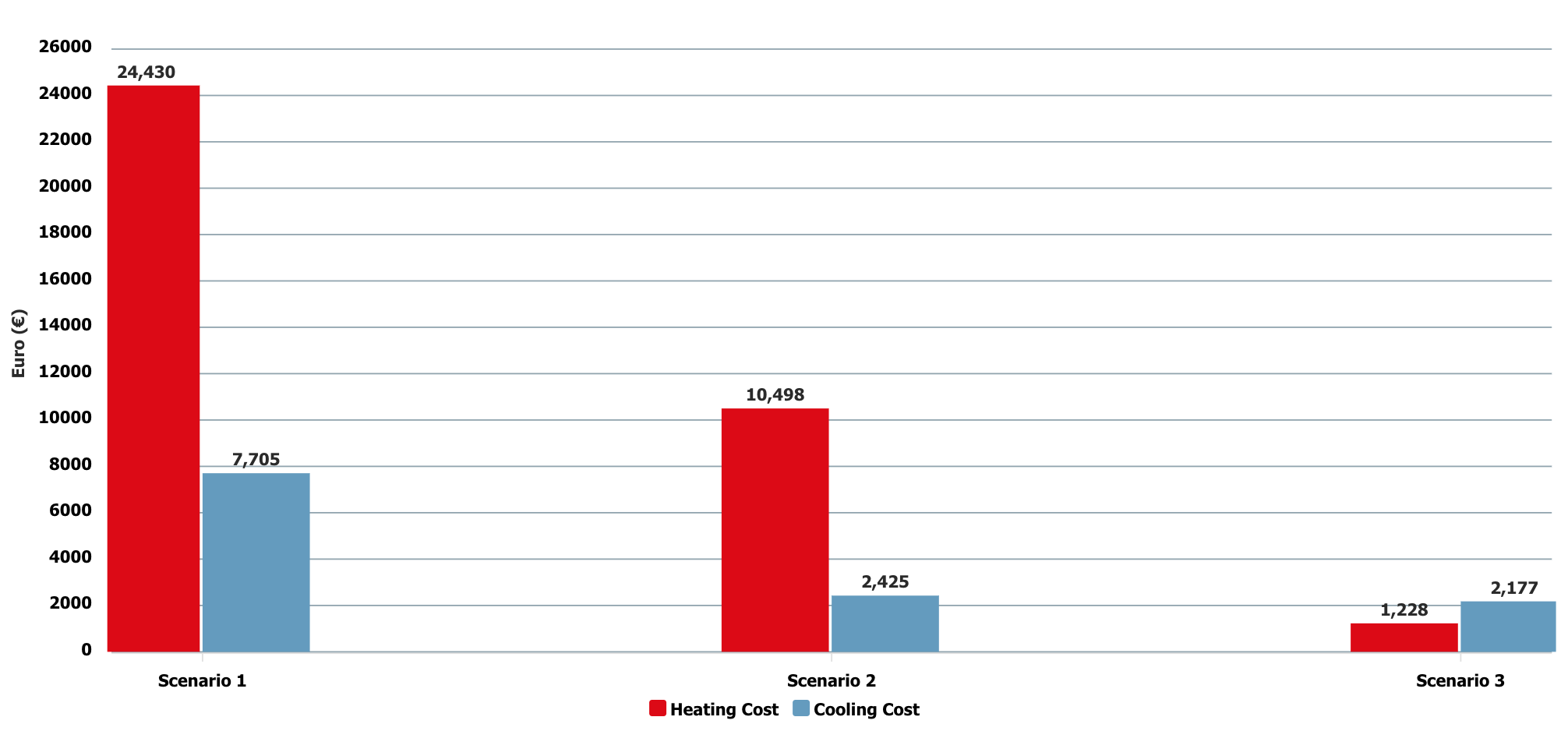
Estimated financial savings before and after renovation, Credits: HPHI
RINNO is a Horizon 2020 project that aims to considerably accelerate the rate of deep renovation in the EU by reducing the time, efforts, and costs involved. We strive to deliver a set of efficient, environmentally friendly, multi-functional, and easily applicable construction-related innovations that are geared in favour of a more sustainable future in the Irish economy.


 This project has received funding from the European Union's Horizon 2020 research and innovation programme under grant agreement No 892071.
This project has received funding from the European Union's Horizon 2020 research and innovation programme under grant agreement No 892071.